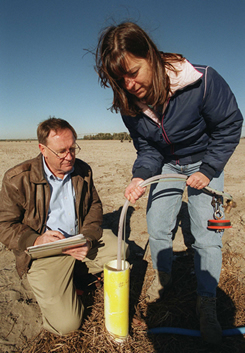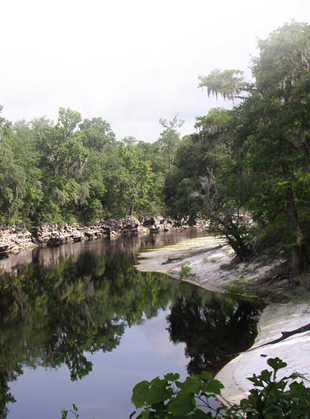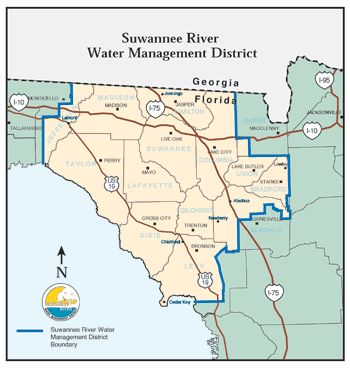|
|
 Years of Research on Nitrate Pollution and Agricultural Solutions to Combat It All Spell Relief for the Historic Suwannee RiverBy Chuck Woods Immortalized in song and verse, the Suwannee River has long been known for its pristine waters, so when tests indicated rising nitrate levels and the environmental problems that accompany them, scientists and citizens through north Florida were spurred to action. “The federal safety standard for nitrate-nitrogen in drinking water is 10 parts per million, but in some areas we were finding levels in the 20-to 30-parts-per-million range,” says David Hornsby, a water resources scientist with the Suwannee River Water Management District in Live Oak. “Rising nitrate concentrations in the river, springs and groundwater have become a regional phenomenon in the past few years.” In addition to compromising drinking water, high nitrate concentrations can degrade water quality in rivers and springs, causing algae blooms that consume oxygen needed by fish and other aquatic animals. In 1999, concerns about nitrates prompted representatives from agriculture, state and federal agencies, local governments and related associations to initiate the Suwannee River Basin Nutrient Management Working Group, now known as the Suwannee River Partnership. The partnership — which includes the University of Florida’s Institute of Food and Agricultural Sciences, or IFAS, and 52 other members — works to develop and promote strategies for monitoring and managing human and animal waste and fertilizer in the basin. Darrell Smith, partnership coordinator with the Florida Department of Agriculture and Consumer Services, says the main goal is to work with landowners and interested groups to help protect the water resources of the Suwannee River Basin through voluntary, incentive-based programs. Results from water-quality monitoring and best management practices (BMP) programs are being made available to all producers and citizens. “The partnership is focusing on finding the most economical and technologically feasible management practices available to help farmers and other land users satisfy the regulatory requirements for protecting public health and the environment,” Smith says. “Through an education and outreach program led by the UF extension service, the partnership will increase public awareness of the issues, encouraging citizen and community participation to find solutions.”
The Middle Suwannee River Basin, which includes Lafayette and Suwannee counties, has hundreds of residential and commercial septic systems in rural areas, about 200 row crop and vegetable farms, 40 dairies with more than 25,000 animals and 130 poultry operations with more than 38 million birds. Suwannee County is the leading poultry production area in the state. Since its inception, the partnership has expanded beyond the Middle Suwannee Basin and now includes all 13 counties in the Suwannee River Water Management District. In addition to working with traditional agricultural producers, the partnership is developing programs with the forestry industry, aquaculture producers and other businesses and homeowners to strengthen the watershed initiative. “All of these activities have the potential to adversely affect water quality in the basin,” says Don Graetz, a professor in UF’s soil and water science department. “At this time, the public perception points to animal waste and fertilizer as the most likely causes. “Surface and groundwaters interact in most of the basin due to the region’s active hydrology and porous soils. The mobility of nitrates, regardless of the source, makes it critical that we carefully evaluate where and how they enter the aquifer,” he says. Graetz, an environmental chemist who leads the UF research and education effort for the partnership, says many state and federal agencies as well as agricultural producers and associations are working toward the common goal of controlling nitrates. A six-year, $2.5 million grant from DEP and the federal Environmental Protection Agency supports the UF work. “The agricultural community, which is key to the area’s economy and green space, is just as concerned about protecting water quality as anyone else, and we’re all working together without finger-pointing or blame,” he says. Graetz and others in the partnership are cooperating with 15 producers in the basin to monitor groundwater quality and evaluate the effectiveness of various BMPs. The program began with three farms: Barnes Poultry Farm in Live Oak, Byrd Dairy Farm in Mayo and Suwannee Farms in O’Brien, which produces row crops and vegetables under more than 40 center-pivot irrigation systems on 5,000 acres. The partnership has installed monitoring wells at seven more dairies and five more poultry operations as part of the BMP project. Kenneth Hall, manager of Suwannee Farms, says the project provides a unique opportunity to observe nitrate movement through the soil in relation to crop development and irrigation or rainfall.
“If we can do a better job of maximizing nutrient and water efficiency while maintaining economic sustainability, we certainly want to be among the first to do so,” he says. George Hochmuth — director of UF’s North Florida Research and Education Center in Live Oak who is developing BMPs for Suwannee Farms — says “considerable progress” has been made in adopting new production practices. “Improvements in the timing and placement of nitrogen fertilizer have allowed farmers to reduce the total amount of nitrogen applied and still achieve high-quality crop yields,” he says. “The key to nitrate management is irrigation management — we are finding that newer and more efficient irrigation nozzles are important for better nitrate management.” Wendy Graham, chair of UF’s agricultural and biological engineering department, is monitoring soil and groundwater quality and water movement, as well as crop nutrient status and crop yields at the vegetable farms. Graham’s team employs data they have been gathering since 1999 to develop computer models for predicting the impact of various nutrient and water management practices on groundwater quality and crop yield under different soil, weather and cropping conditions. “We have a weather station and a network of monitoring wells under one of the large, center-pivot irrigation systems,” she says. “Through this monitoring we have been able to pinpoint the types of weather conditions and crop management practices that result in nitrate leaching. This information has allowed us to make recommendations about practices that will reduce nitrate loading to groundwater.” Graham said the research has demonstrated, on a commercial scale, a suite of improved practices that reduce loads to groundwater while maintaining acceptable crop yields. “But,” she says, “demonstrating that these practices, if implemented throughout the Suwannee Basin, will meet existing and future water-quality standards is a challenge that requires further research and development.” Rao Mylavarapu, an assistant professor and nutrient management specialist in the soil and water science department, is helping to develop nutrient management plans that account for all nutrients applied to the crops at the three demonstration farms in the partnership. “We need to develop new cropping systems based upon the exact nutrient needs of plants, which will minimize nutrient losses to the environment,” Mylavarapu says. “The efficiency of nutrient utilization by crops can be improved by fine-tuning existing fertilization practices, thereby reducing nutrient leaching through the soil into groundwater. New BMPs that combine nutrient and water management, particularly application rates and timing, will hopefully optimize cultural practices in the Suwannee Valley Basin.”
Nutrient management plans, which incorporate various BMPs, for Byrd Dairy Farm and Barnes Poultry Farm were developed by another partnership member, the U.S. Department of Agriculture’s Natural Resource Conservation Service. Conservation management practices for dairy and poultry farms include application of animal waste on pastures and other crops. Hochmuth says researchers at IFAS Livestock Waste Testing Lab in Live Oak are working with the partnership to provide precise analysis of nutrients in manures at the animal farms. The UF lab is funded by partnership members. “This gives producers a better idea of what nutrients are being applied to crops and fields,” he says. “Researchers at the center are also developing other BMPs for crops in the Suwannee River Basin area, including vegetables and Don Graetz Wendy Graham George Hochmuth
Studying the SuwanneeThe Suwannee River is one of the nation’s most famous waterways. Now a team of nearly 100 researchers from the University of Florida and a host of other universities and government agencies hope to make it one of the most studied, as well. Just as astronomers employ telescopes to better understand outer space, earth scientists hope to gather unprecedented amounts of data about individual river watersheds in an effort to better understand the nation’s entire hydrologic system. The National Science Foundation is expected to issue a request for proposals within the next year to fund up to 10 National Hydrologic Observatories at up to $25 million each for five years. About two dozen groups around the country are vying to have their project selected by NSF, including the Suwannee River team.
“The Suwannee is ideal for an observatory for both pure scientific reasons as well as practical environmental applications,” says UF geological sciences Associate Professor Jon Martin. “Our proposal will focus on the impact of humans on the watershed — how they have altered it and how much further alteration it can handle.” The researchers cite four major characteristics of the Suwannee River watershed that make it an ideal choice to be a hydrologic observatory. • The river is one of few major rivers in the United States that is largely unregulated by dams or other structures, and its water quality is good enough to earn it a designation by the Environmental Protection Agency as one of 12 National Showcase Watersheds. • Urbanization and agriculture are increasing in the river’s watershed, bringing with them an apparent increase in nutrient loads and decline in water quality. In addition, population growth is fueling increased groundwater withdrawals from the Floridan aquifer for local consumption. • The watershed comprises three distinct, but linked, hydrologic landscape units. The upper river is largely separated from the Floridan aquifer; the middle river is fed by both surface water and the aquifer; and the lower river discharges into an estuary. • Data exist about the river as far back as the early 1900s. More recently, the US Department of Agriculture’s Southeast Watershed Research Laboratory has monitored the river’s headwaters in Georgia since 1965, and the Suwannee River Water Management District has monitored the watershed in Florida since 1972. Martin says the team will not be able to write the proposal until it receives the guidelines from NSF, but he adds: “We expect the hydrologic observatory will be designed to make all necessary observations about a single watershed, from the atmosphere to the base of the groundwater.” The Hydrologic Observatory program is being coordinated through an organization of nearly 100 universities around the country called the Consortium of Universities for the Advancement of Hydrologic Science, Inc., or CUAHSI. In addition to promoting the gathering data about individual rivers, the NSF program encourages the sharing of data between observatories in different ecosystems. “Eventually a network of Hydrologic Observatories collecting similar data will be created so that comparisons can be made across climatic and physiographic zones,” according to the CUAHSI Web site. UF’s partners in the Suwannee River proposal include Florida State University, the Suwannee River Water Management District, the Florida Department of Environmental Protection, the Florida Geological Survey, the University of Georgia and the U.S. Geological Survey. Jon Martin
|




